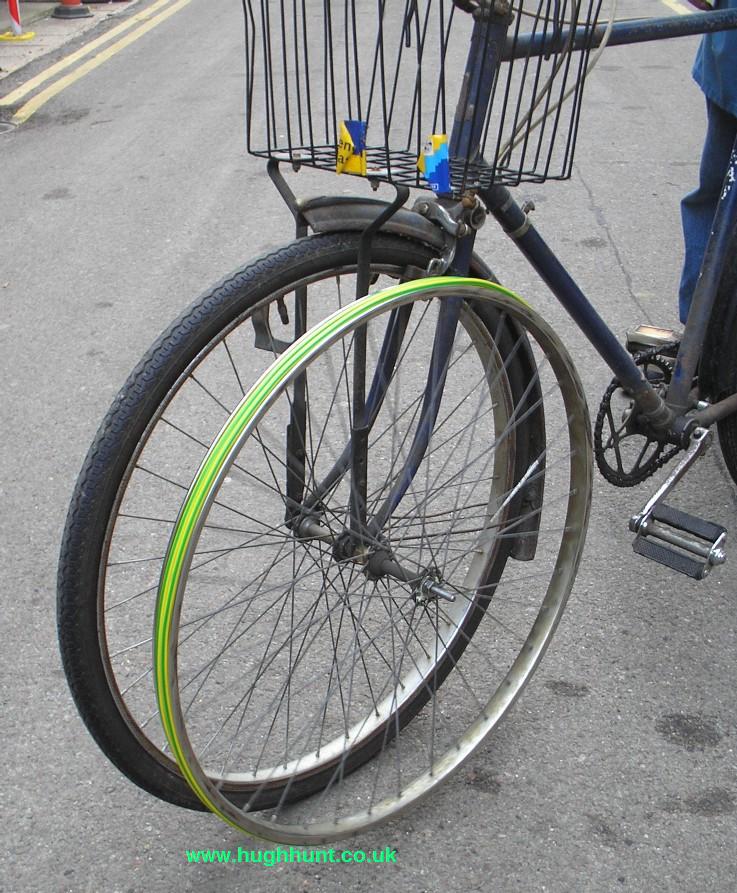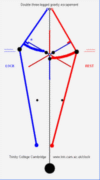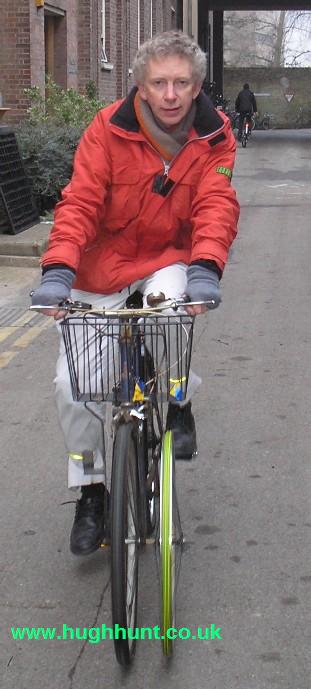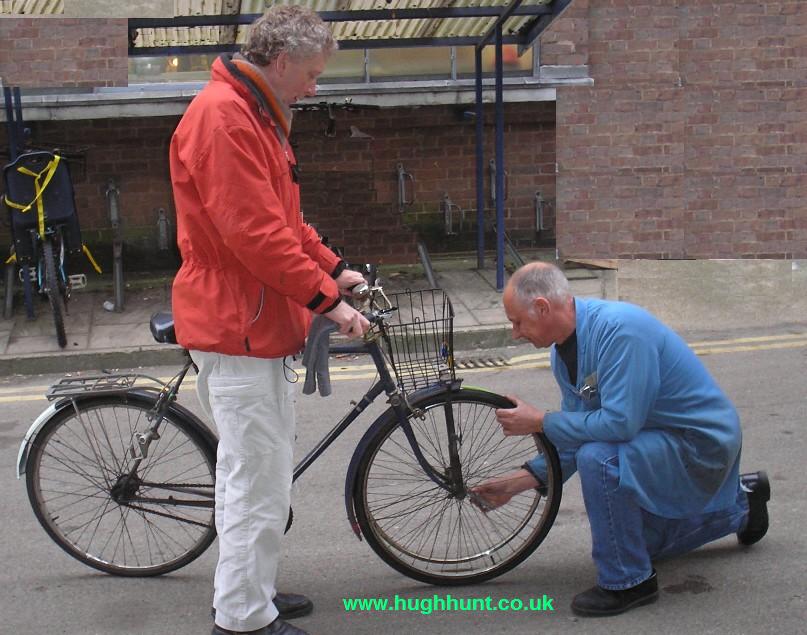
Bicycles are not held up by the gyroscopic effect
including a bike with a reverse-spinning wheel
Dr Hugh Hunt
@hughhunt
Dynamics movies page

![[Univ of Cambridge]](http://www.eng.cam.ac.uk/images/house_style/uniban-s.gif)

![[Dept of Engineering]](http://www.eng.cam.ac.uk/images/house_style/engban-s.gif) Trinity College Clock
Trinity College Clock


|
Bicycles are not held up by the gyroscopic effect
|
For fun stuff on spinning things go to Dynamics movies page 
|
The photos below catalogue an experiment which proves that the gyroscopic effect is small.

|
Here I am pictured riding an ordinary bike, but with an extra wheel attached to the front axle. The tyre has
been removed to give a little clearance from the road
and some copper cable (earthing cable with green insulation) wound around the rim in its place to replace the moment
of inertia due to the tyre.
The "extra" wheel can be spun up by hand, before you start riding, at any speed you like, even several times the speed of spinning of the "actual" wheel. It can be spun either forwards or backwards and what is so clear is that it really makes no difference to the "ride" of the bike. The bike is just as easy to ride whether the extra wheel is spinning or not, forwards or backwards, fast or slow. So this makes us wonder: "How do we stay up on a bicycle"? The way we stay upright on a moving bike is by active control through steering. This is why we have to learn to ride a bike. If, as learners, we find ourselves falling over to the left then we learn to steer the bike to the left, which generates forces that tilt us back upright again, thereby putting the wheels back under our centre of gravity. Beginners are very wobbly, but as we become expert the corrections become smaller and we can ride in a straight line. The faster we ride, the smaller the steering adjustment needs to be, simply because the bike moves much further in a given time. When riding very slowly the steering adjustments required are very large. When completely at rest, active steering can do nothing for us. A good analogy is to ask, "Why is it easier to hop (or pogo-stick) along a straight path than it is to stand still on the ball of one foot?" The reason is that we use each hop to generate correcting forces and also to put our foot down in a new place that is closer to where we need it to be in order to maintain our balance. |
Also note that a bike with no rider can stay up much more easily - as many of the bloggers responding to this article have said. This is because the bike is now much lighter and the centre of gravity is much lower. So the forces acting to cause the bike to fall over are smaller. This means now that both "trail" and gyro effects are much more significant in the overall dynamics of the bike and it stays up more easily.
My point is that gyroscopic effects are not needed to keep you from falling over when you are riding in a straight line. I am not saying anything about what happens when you actively wish to steer away from straight ahead.

|
Let's do the math - some simple sums show clearly why the gyroscopic effect is unimportant:
When riding quite fast at 12 mph, ie 6 m/s, a typical bike wheel (diameter 600 mm, circumference 2 m) rotates 3 times per second, which is a
spin rate of
|
Note that 12 mph is quite speedy for most ordinary riders: at slower speeds the gyroscopic effect is even less significant. I know that the racing cyclists amongst you reading this will think that 12mph is very slow - but please bear in mind that this web page is inteded to be read and understood by all cyclists, and most families on their sunday outings would rarely reach 12mph. The point I'm making is that even at relatively modest speeds a bike will stay up - and it's not gyro effects that are resposible.
Misconception 2: Anyone who has held a bike wheel in their hands and has felt the huge gyroscopic effect
will swear that the forces are huge - so large that they simply must be important when riding a bike. But consider this:
when holding the axle of the bike
wheel in my fingers I notice that the force is big but it can't possibly be more than a few kg at best - ie a few percent of my body weight
- because my fingers are not all that strong. So when I ride a bike the gyro effect at the ends of the forks is only a few kg - nothing
compared with the 100 kg or so that the combined weight of the bike and rider exert. This is effectively saying the same thing that was
deduced by calculation above, ie that gyro effects are there but small compared with other things.
Misconception 3: The gyroscopic effect holds a bike up so you can ride a bike with the handlebars locked. NO! Try it. You fall over immediatly.
The easiest way to do this is with a rope. Tie your handlebars to the cross bar and then tournequet the rope really tight.
You will have trouble even getting started. Get someone to push you along, or ride down a hill. Be prepared to fall!

| Gareth Ryder, as usual, has been very helpful. |

|
This close-up photo shows the extra wheel. You can see that the tyre has
been removed (this gives a little clearance from the road)
and in its place some earthing cable has been wound around the rim so that the moment
of inertia of the wheel is roughly the same as it would be for a wheel with a tyre.
Note that the forks on all bicycles are inclined, and curved. This geometry means that if I tilt to the left the steering automatically turns the bike to the left, thereby putting the wheels back underneath me. This automatic corrective contrivance is essential for a bike to be ridden "hands free". It is this geometry that works wonders for us, and the gyroscopic effect is a smaller consideration.
|

| This is the neat little brass adapter that Gareth made up for me to allow the extra wheel to be attached to the front axle (I should have cleaned it up a bit before taking this photo!) |
References
I'm not the only one to have done these experiments and calculations and to have reached the same conclusions.
Take a look at the work of the following people:
|
(For other gyroscopic things: go to
Gyro and boomerang page

and for all sorts of video clips on spinning things go to:
Dynamics movies page

and for other stuff: go to Hugh Hunt's Cambridge University home page )